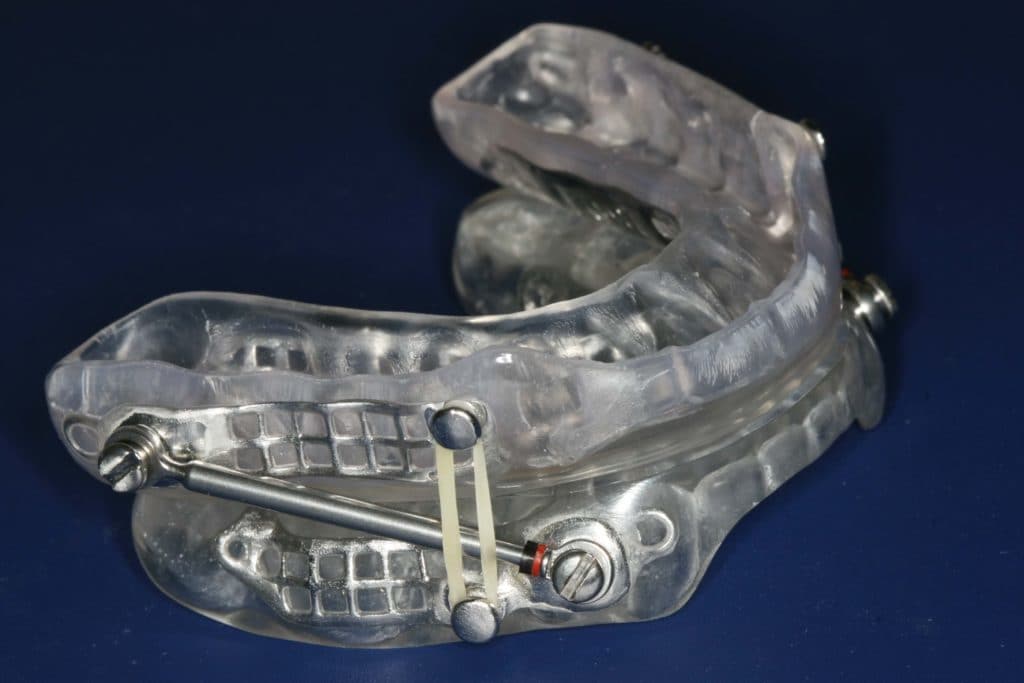How Does a Sleep Apnea Oral Appliance Work?

There are several treatment options for sleep apnea.
One of the options is the oral appliance. These sleep apnea oral appliances are
custom made by dentists using a plastic-like mold to form to the specific shape
of the patient’s teeth and mouth. Not only do they work against sleep apnea,
they are also effective to stop snoring.
Benefits
of Oral Appliance Therapy for Sleep Apnea
- Improved compliance of therapy compared to other treatments for sleep apnea
- Device can fit in a pocket
- Device is not visible to bed partner when mouth is closed
- Most patients see improvement on the first night
- The device does not use any electricity. You don’t have to plug the device into a wall to function.
Sleep apnea oral appliances work by moving the jaw
forward, which increases the size of the upper airway, thus reducing the air
resistance that leads to sleep apnea and snoring. Oral appliances for sleep
apnea are often used as a substitute for CPAP or sleep apnea oral surgery. It
is often used in conjunction with weight loss if the individual is overweight.
Sleep apnea mouth guards are anti-snoring devices. They reduce airway
turbulence and stop snoring.

How
Oral Appliances Treat Bruxism
These devices not only treat sleep apnea, they also
cure grinding. Grinding is the instinctual response by the body when you stop
breathing at night. The back and forth motion of grinding is an effective way
of reopening a collapsed airway. Even though grinding is what saves us, it
comes at a cost. Not only does grinding slowly destroy your teeth, but if
you’re grinding, you’re being aroused out of deep sleep because you can’t
breathe. Therefore, you treat the root cause — the sleep apnea — and you take
away the need for the body to grind the teeth.
Oral
Appliance Therapy
For mild to moderate sleep apnea, oral appliance
therapy offers many of the same health benefits as CPAP. By treating your sleep apnea, you can reduce
your risk for heart disease, stroke and diabetes. You will also improve your
daytime alertness, concentration and emotional stability. Dentists work closely
with physicians to treat snoring and sleep apnea. At your first visit, your
dentist will talk to you about the benefits of treatment. You also will receive
information on the potential side effects and the cost of therapy. Then your
dentist will conduct a complete clinical evaluation. This will include an
examination of your teeth, jaw, tongue and airway, and possibly a new X-ray of
your mouth.
Oral appliances are customized using digital or
physical impressions and models of your teeth. These models are sent to a
dental lab where the appliance is made. Once your oral appliance is ready, you
will return to your dentist’s office for a fitting. Your dentist will adjust
the appliance to maximize its comfort and effectiveness. You also will learn
how to clean the oral appliance and maintain it. After this fitting, your sleep
doctor may schedule you for a sleep study to verify treatment success.
The development of oral appliance treatment for OSA
represents an important step in the management of this disease. Randomized,
controlled clinical trials have shown them to be an effective treatment option
for snoring and OSA in some patients, particularly patients with less severe
OSA or simple snoring and patients who have failed other treatment modalities.
Although oral appliances are not as effective as CPAP therapy, they work in
most patients to relieve symptoms and apnea and are well tolerated by patients.
Most patients report improvements in sleep quality and excessive daytime
sleepiness.
Thanks for taking the time to share this informative information with us. I enjoyed going over all the details that you provided in this article. Have a great rest of your day and keep up the excellent work.
ReplyDeleteDental Implant Dentist Philadelphia
great way to describe it dentist northeast philadelphia will be pleased to see this
ReplyDeleteThis is a really insightful article on the mechanics of sleep apnea oral appliances and how a custom device provides an effective, non-invasive solution. It’s fascinating how precision in design—like moving the jaw forward—can solve a complex health problem.
ReplyDeleteThe emphasis on long-term prevention and structural integrity is relevant across many fields. For homeowners, protecting a structure from damage requires similar foresight and precision. That’s why hiring a reliable waterproofing contractor for foundation work is crucial—it's preventative health for your home! For anyone needing information on long-term moisture protection for their property, you can check out wet2drysolution.com.
Thanks for shedding light on this important dental health option!
This was such an informative post about how oral appliances help with sleep apnea! It’s fascinating to see how thoughtful design can make a real difference in comfort and health. At Leakfoe, we share that same commitment to precision and long-term results. As a waterproofing contractor in India, we focus on diagnosing issues accurately and providing durable protection — ensuring every home breathes just as easily as a good night’s rest allows.
ReplyDelete